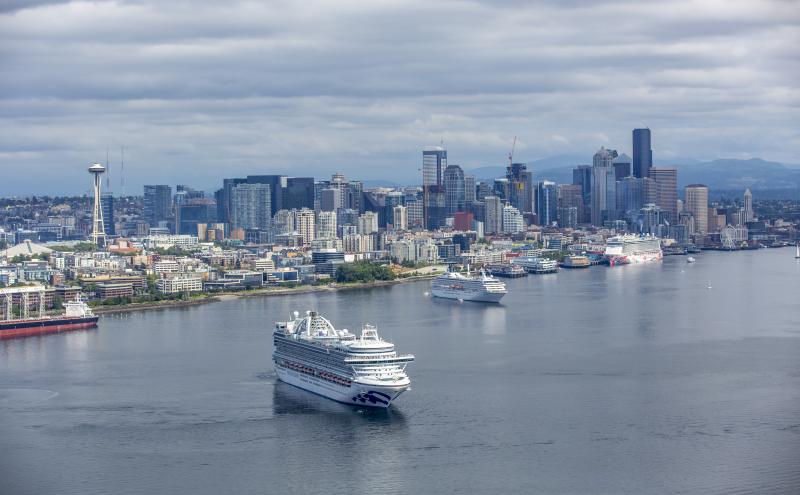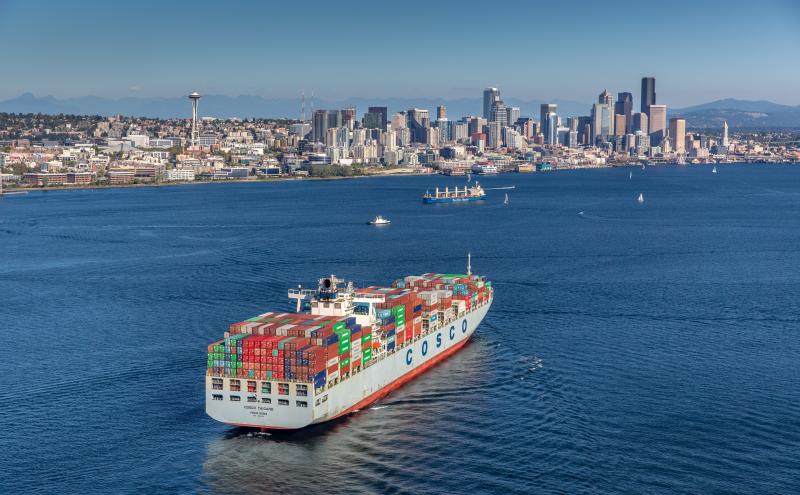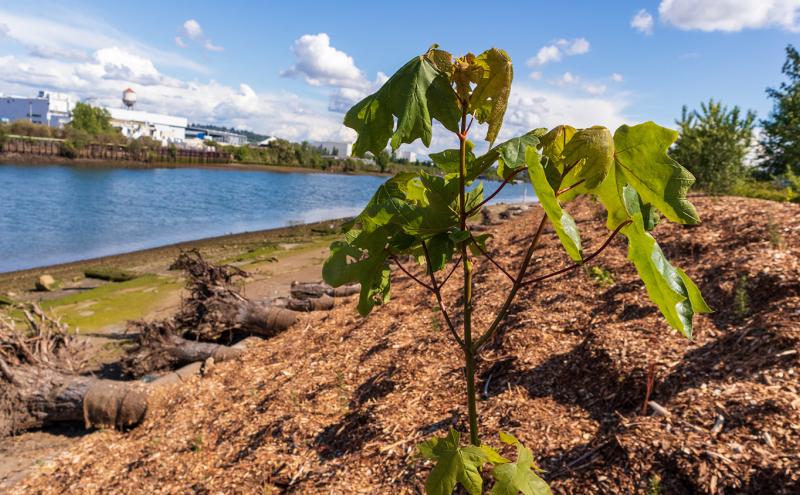
By Ryann Child, Senior Environmental Management Specialist, Maritime Environment & Sustainability
As we welcome crisper days, longer nights, and the change of the seasons with fall, it is hard not to forget the roasting hot days of summer 2021. In fact, this past summer was one of the hottest on record with the highest historical temperatures in Puget Sound. And our region is not alone in these extreme weather events.
The time is now
To avoid the most extreme impacts of climate change, the International Panel on Climate Change (IPCC) determined that global temperature increase must be limited to 1.5 degrees Celsius (°C) above pre-industrial levels. (Source: IPCC Summary for Policymakers). In the IPCC’s latest report released in August 2021, scientists found climate change is intensifying and observed changes in the climate across every region on Earth. The report has sounded the alarm that “immediate, rapid and large-scale reductions in greenhouse gas emissions” are needed to curb warming and stabilize the climate.
At the Port of Seattle, we’re acutely aware how climate change impacts our community and customers, so we’re planning for the future. Rising temperatures, changing weather patterns, and reduced snowpack threaten access to relatively clean, affordable electricity from hydropower. Climate change may also affect production of agricultural exports that move through seaport terminals. Sea-level rise and storm events threaten marine terminal infrastructure, stormwater systems, Port properties, and cargo movements at our seaport and ports throughout the world.
Furthermore, the adverse impacts of climate change will be felt earlier and more acutely by historically marginalized communities, including Black, Indigenous, and people of color (BIPOC), and those who already bear a disproportionate burden of exposure to air pollution and environmental hazards. People who live in South Park and Georgetown, adjacent to Port terminals, and industrial properties along the Duwamish River have a life expectancy up to 13 years shorter than wealthier parts of Seattle (Source: Duwamish Valley Cumulative Health Impacts Analysis).
This fall, the Port of Seattle will finalize a plan to reach a carbon-free maritime future by 2050. Following the April 2021 adoption of the 2020 Northwest Ports Clean Air Strategy (NWPCAS), Charting the Course to Zero: Port of Seattle’s Maritime Climate and Air Action Plan puts forward strategies and near-term local actions by the Port to achieve the 2020 NWPCAS goals.
The 2020 Northwest Ports Clean Air Strategy Vision:
Phase out emissions from seaport‐related activities by 2050, support cleaner air for our local communities, and fulfill our responsibility to help limit global temperature rise to 1.5°C.
What is the Port doing to address climate change?
The Maritime Climate and Air Action Plan (MCAAP) is the Port’s first ever comprehensive plan to address climate change and air pollution from maritime sources. The MCAAP charts a course to achieve the Port’s Century Agenda target of a 50% reduction in greenhouse gas (GHG) emissions by 2030 and implement the NWPCAS vision to phase out emissions from seaport-related sources by 2050. The MCAAP identifies and evaluates the impact of emission reduction strategies for scope 1, 2, and 3 GHG emissions and diesel pollution from the Port’s maritime-related operations.
This plan will address and decrease emissions from the following sources:
| Port Maritime Administration Emissions Sources | Maritime Activity Emissions Sources |
|---|---|
|
|
The MCAAP also outlines the Port’s habitat restoration programs and acknowledges the future carbon sequestration potential of shoreline and marine habitats. The scope of the MCAAP does not include GHG or air pollutant emissions associated with Seattle‐Tacoma International Airport (SEA) or marine cargo terminals operated by the Northwest Seaport Alliance (NWSA). The NWSA is completing a complementary NWPCAS implementation plan that details actions to reduce emissions from cargo operations in Seattle and Tacoma.
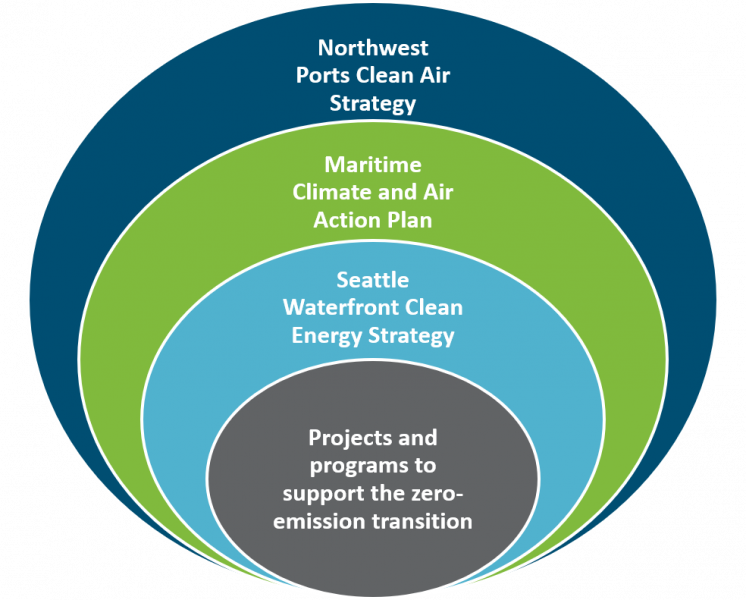
Who was involved in creating this plan?
The Port began developing the MCAAP alongside the 2020 NWPCAS. Both documents were informed by a two‐year engagement process with community, environmental, and health advocacy organizations, industry representatives, and Tribal, federal, state, and local government agencies in the Puget Sound region. Here is the process to date:
- The Port began working on a renewal to the NWPCAS with the NWSA, Port of Tacoma, and Vancouver Fraser Port Authority starting in 2018. The Port partnered with the other U.S.-based organizations, NWSA and Port of Tacoma, on engagement. The port organizations set up a representative panel of community, industry and government representatives and convened three rounds of workshops, meetings, and written comments between spring 2019 and late fall 2020. The NWSA also conducted a survey of the trucking community that collected over 100 responses.
- After adopting the 2020 NWPCAS in April 2021, the Port, the NWSA, and the Port of Tacoma responded to public requests for additional time to review and engage on the details of implementation in the Seattle and Tacoma harbors.
- Over summer 2021, the Port partnered with the NWSA and Port of Tacoma on an engagement process focused specifically on local actions proposed to implement the NWPCAS vision with targeted outreach to near-port communities. The summer engagement process included:
- a dedicated webpage with links to each organization’s implementation plan
- a community reader’s guide to and summary of the full MCAAP draft
- an online survey available in six languages (139 responses)
- two public webinars
- targeted outreach to neighborhood groups
- meetings with industry, government, non-profit, and community-based organizations;
- three interactive workshops
What did you hear from the community?
Engagement feedback grouped into these themes:
- Strong consensus on the need to achieve zero emission operations by 2050 and to prioritize clean energy transition
- Feedback on the importance of interim emission reduction targets
- Desire for the ports to lead by example and prioritize climate and clean air investments to address health disparities in environmental justice communities
- Desire for more accountability, communication, and transparency in reporting and decision-making by the ports
- Consensus on the importance of reducing emissions from trucks, with concerns raised about cost, feasibility, and equity for drivers
- Concerns about oceangoing vessels as a major source of emissions and the impacts of vessel traffic on marine life
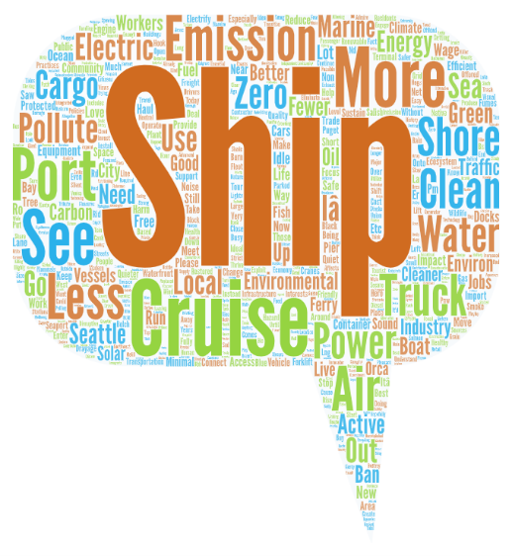
This community feedback helped inform the content of the final MCAAP, including changes to actions that now better reflect community priorities. Updates were made to the MCAAP to acknowledge alignment between the plan and priorities in the newly developed Duwamish Valley Clean Air Program Action Plan. Actions were also added to reflect commitments to youth engagement and prioritizing local and women and minority-owned business enterprises in implementation. In response to requests for more accountability, the ports added commitments to regular updates and engagement on clean air strategy implementation and developed a common accountability framework to more clearly report on progress.
A detailed list of the changes the Port made to its MCAAP, together with changes made to the NWSA and Port of Tacoma implementation plans, were summarized publicly in a report-out webinar and detailed in an engagement summary posted on our website.
How will the Port reduce maritime-related emissions?
Key actions to be taken by 2030 include:
- Collaborating with community, industry, and government to reduce emissions
- Converting 100% of Port-owned light-duty vehicles to electric or renewable fuel sources
- Eliminating the use of fossil natural gases in Port-owned buildings
- Installing shore power infrastructure at all cruise ship berths
- Requiring that 100% of home port cruise ship calls connect to shore power
- Completing the Seattle Waterfront Clean Energy Strategy (SWCES) and establishing industry and utility partnerships to deploy infrastructure for zero-emissions equipment, locomotives, vehicles, vessels, and buildings
How will the Port track progress?
The Port will report annually on progress against performance metrics set within the plan for each sector. To track emission trends, the Port of Seattle conducts annual inventories of GHG emissions from its maritime administrative sources and publishes the results online. The Port is also involved in a larger inventory of all maritime-related air and GHG emissions in Puget Sound, the Puget Sound Maritime Air Emissions Inventory, which is updated every five years.
The Port — along with the Port of Tacoma, the NWSA, and the Vancouver Fraser Port Authority — will review and update the Northwest Ports Clean Air Strategy vision and objectives every five years. The ports will also conduct a regular review of the actions and timelines and update commitments to reflect changes in the policy, funding, and technology landscape.
How can I stay involved?
The Port is committed to ongoing engagement on the MCAAP even after the plan is adopted to identify emission reduction projects, align with community priorities, and report on progress.
Send an email to join the Clean Air mailing list or ask a question. And stay tuned for more opportunities to provide input.
Parallel efforts in aviation
This blog focuses only on efforts in the maritime plan and division, but parallel efforts to address future climate impacts are happening in the aviation division. Seattle-Tacoma International Airport (SEA) has implemented projects to reduce emissions including:
- Becoming the first airport to use low-carbon renewable natural gas to heat the terminal
- Setting a goal to use sustainable aviation fuels in every flight by 2028
- Electrifying ground support equipment since 2015

